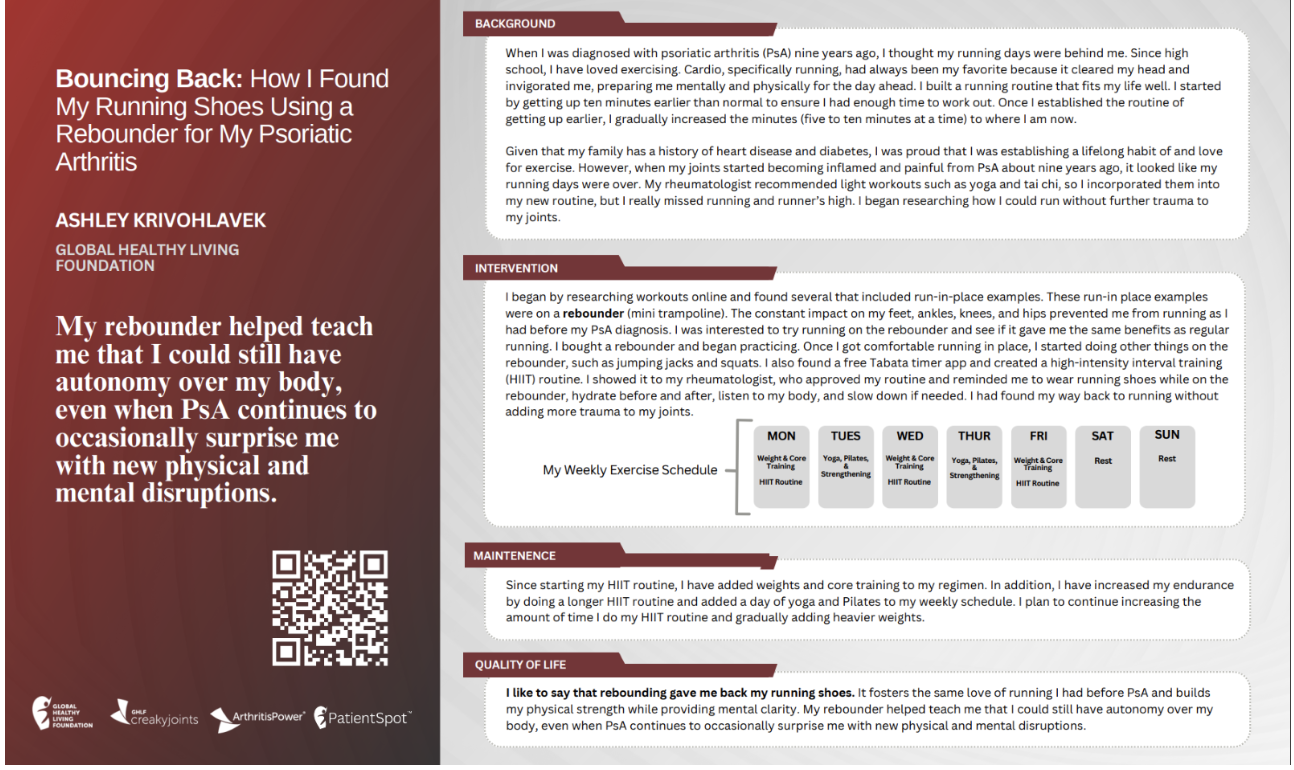

When Ashley, 39, was diagnosed with psoriatic arthritis (PsA) nine years ago, she believed her running days were over. Her love of running, which had been with her since high school, was a cherished part of her daily routine, providing mental clarity and physical vigor. With a family history of heart disease and diabetes, consistent exercise was important to Ashley.
However, PsA brought painful joint inflammation, seemingly dashing her hopes of continuing her running routine. Her rheumatologist recommended gentler activities like yoga and tai chi, which she incorporated into her routine.
Still, Ashley missed the feeling of running and the “runner’s high” it provided, so she set out to find a way to run that wouldn’t tax her joints. After conducting extensive online research, she discovered run-in-place exercises on a rebounder, a mini trampoline that offered reduced impact on her feet, ankles, knees, and hips. Eager to determine if this approach could replicate the benefits of regular running, she purchased a rebounder and began practicing.
As she grew more comfortable with running in place, she expanded her rebounder workout to include exercises like jumping jacks and squats. She also designed a high-intensity interval training (HIIT) routine using a free Tabata timer app.
Ashley shared her rebounding routine with her rheumatologist, who approved it, encouraging her to wear proper running shoes on the rebounder, stay hydrated, pay attention to her body’s signals, and adjust her pace as needed. Through these efforts, Ashley successfully reintroduced running into her life without causing additional stress to her joints.
In terms of maintenance, she gradually incorporated weights and core training into her regimen. She also extended the duration of her HIIT routine and included yoga and Pilates on a weekly basis. Her future plans involve increasing the duration of her HIIT routine and using heavier weights.
Ashley was finally able to get back the joy of running she cherished before her PsA diagnosis. “You get a good cardio rush from it,” she says.
The rebounder also offered Ashley a sense of control over her body, even as PsA continued to introduce new challenges. “My rebounder taught me that I could still have autonomy over my body, even when PsA continues to occasionally surprise me with new physical and mental disruptions,” she says.
Now, Ashley is excited to present her routine in her poster “Bouncing Back: How I Found My Running Shoes Using a Rebounder for My Psoriatic Arthritis” with other patients and providers at the 2023 American College of Rheumatology (ACR) Convergence.
What Ashley Learned That Could Help You Too
Here, we talk with Ashley about her experience submitting a patient poster for ACR and what she hopes others will take away from her learnings. Read more about Ashley in “How One Woman Found Her Way Back to Exercise With PsA.”
CJ: Tell us about your poster.
Ashley: “At the core, it’s about finding an exercise routine that is fun, that you can enjoy, and that gives you a decent workout with low impact on joints. I can involve my whole body and not feel the impact on my joints from it.
CJ: Why was this topic important to you?
Ashley: “Exercise is so important for people with autoimmune conditions — we are always told “motion is lotion” but to go low impact. There are people who don’t have access to swimming or to take a brisk walk around the neighborhood. Some people cannot do that due to weather conditions and safety issues. You can still get a good cardio workout that’s moving your muscles that’s low impact. It helps with core, too.”
CJ: Why is it important to showcase this poster at a forum like ACR?
Ashley: “A lot of times we get a linear focus so doctors won’t have a lot of time to coach patients on proper nutrition and proper exercise. When health professionals suggest walking or swimming, those activities require people to plan for these activities. It’s not feasible for everyone to be able to get out the house all of the time. I hope this is more accessible than swimming or just a brisk walk might be. I hope it helps others think outside of the box of things we already know.”
Key Takeaways for Exercising with Chronic Illness
Here are a few more lessons Ashley learned along the way about exercising with PsA.
- Create a balance of workouts. Ashley was consistent with the rebounder but not as consistent with yoga and Pilates, and now she’s noticing her flexibility has diminished somewhat. “The combination is necessary to build flexibility and stretch muscles,” she says.
- Balance the types of exercises you do. Switch up your routine with a combination of practical exercises that meet your needs. Ashley avoids redundancy by varying her workouts with Pilates, yoga, walking, weightlifting, and using a rebounder trampoline.
- Be creative in your routine and have fun. “It’s really about what you’re comfortable doing but also pushing yourself a little outside of your comfort zone,” she advises. “Running on a treadmill could be boring so find that exercise passion.”
- Choose how you manage your health. “I hope people see that even though you have this chronic illness and you’ll live with it forever, you can choose how to manage it,” she says. “You might not be able to do everything exactly as you did prior to your diagnosis, but you can adapt. Resilience is hard to maintain with a chronic illness.”
Be a More Proactive Patient with ArthritisPower
ArthritisPower is a patient-led, patient-centered research registry for people living with chronic conditions. You can participate in voluntary research studies about your health conditions and use the app to track your symptoms, disease activity, and medications — and share with your doctor. Learn more and sign up here.
Krivohlavek A. Bouncing Back: How I Found My Running Shoes Using a Rebounder for My Psoriatic Arthritis. Arthritis & Rheumatology Journal. 2023. https://acrabstracts.org/abstract/bouncing-back-how-i-found-my-running-shoes-using-a-rebounder-for-my-psoriatic-arthritis/.





